

Compact Muon Solenoid
LHC, CERN
| CMS-SUS-18-001 ; CERN-EP-2018-109 | ||
| Constraints on models of scalar and vector leptoquarks decaying to a quark and a neutrino at $\sqrt{s} = $ 13 TeV | ||
| CMS Collaboration | ||
| 25 May 2018 | ||
| Phys. Rev. D 98 (2018) 032005 | ||
| Abstract: The results of a previous search by the CMS Collaboration for squarks and gluinos are reinterpreted to constrain models of leptoquark (LQ) production. The search considers jets in association with a transverse momentum imbalance, using the $ {M_{\mathrm{T2}}} $ variable. The analysis uses proton-proton collision data at $\sqrt{s} = $ 13 TeV, recorded with the CMS detector at the LHC in 2016 and corresponding to an integrated luminosity of 35.9 fb$^{-1}$. Leptoquark pair production is considered with LQ decays to a neutrino and a top, bottom, or light quark. This reinterpretation considers higher mass values than the original CMS search to constrain both scalar and vector LQs. Limits on the cross section for LQ pair production are derived at the 95% confidence level depending on the LQ decay mode. A vector LQ decaying with a 50% branching fraction to $ {\mathrm{t}\nu} $, and 50% to $ {\mathrm{b}\tau} $, has been proposed as part of an explanation of anomalous flavor physics results. In such a model, using only the decays to $ {\mathrm{t}\nu} $, LQ masses below 1530 GeV are excluded assuming the Yang-Mills case with coupling $\kappa = $ 1, placing the most stringent constraint to date from pair production of vector LQs. | ||
| Links: e-print arXiv:1805.10228 [hep-ex] (PDF) ; CDS record ; inSPIRE record ; CADI line (restricted) ; | ||
| Additional information on efficiencies needed for reinterpretation of these results are available here. Additional technical material for CMS speakers can be found here. |
| Figures | |

png pdf |
Figure 1:
Dominant LO diagrams for LQ pair production in proton-proton collisions. |

png pdf |
Figure 1-a:
One of the dominant LO diagram for LQ pair production in proton-proton collisions. |

png pdf |
Figure 1-b:
One of the dominant LO diagram for LQ pair production in proton-proton collisions. |

png pdf |
Figure 1-c:
One of the dominant LO diagram for LQ pair production in proton-proton collisions. |
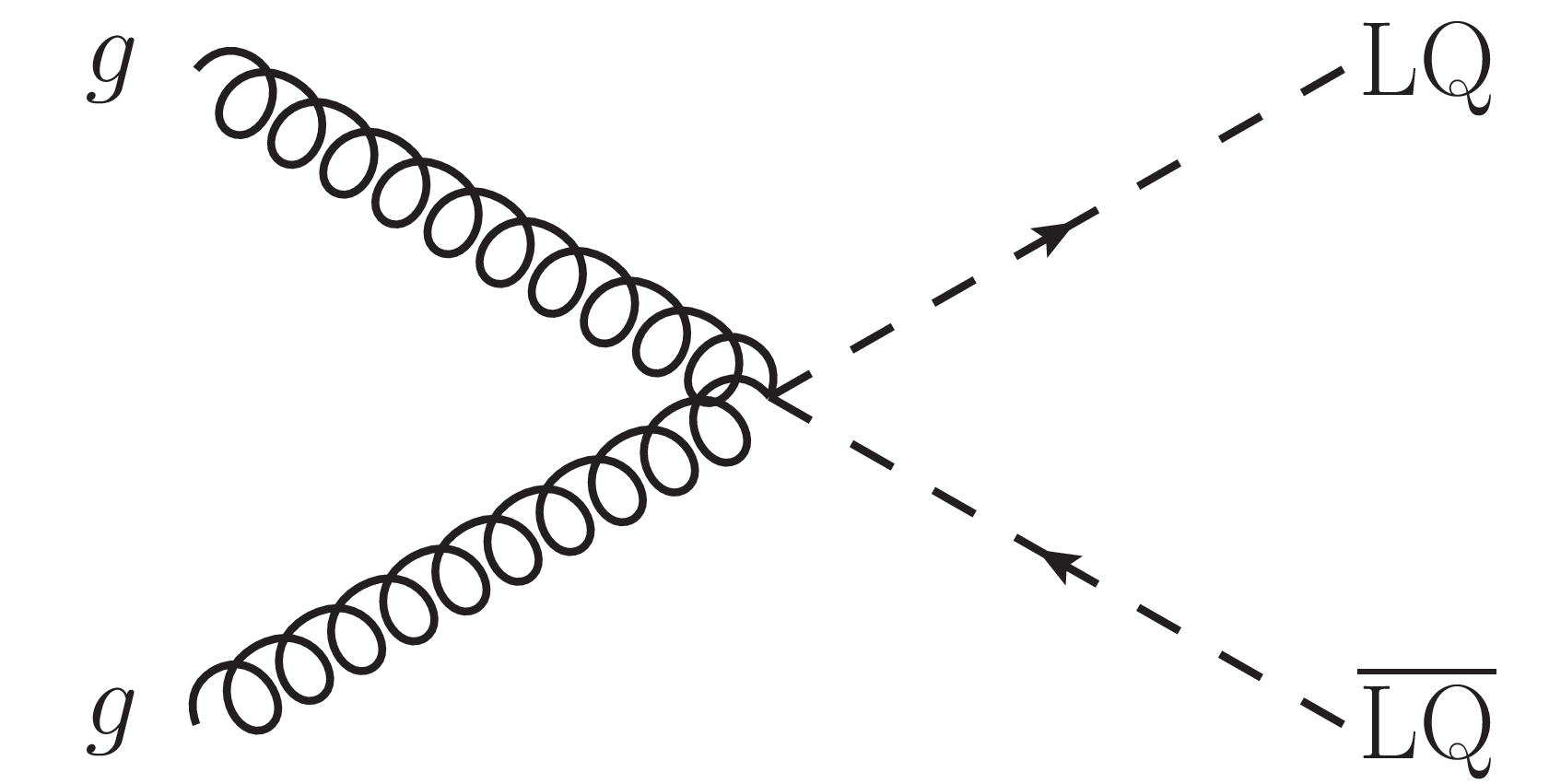
png pdf |
Figure 1-d:
One of the dominant LO diagram for LQ pair production in proton-proton collisions. |
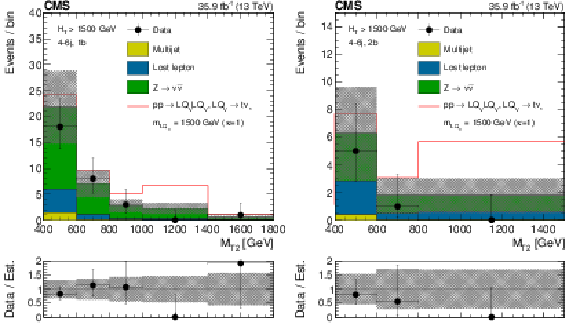
png pdf |
Figure 2:
Distributions of $ {M_{\mathrm {T2}}} $ showing data, the background predictions, and a hypothetical $ {\mathrm {LQ}_{\mathrm {V}}} $ signal with LQ mass of 1500 GeV decaying with 100% branching fraction to $ {{\mathrm {t}} {\nu}} _{\tau}$. The cross section used for the $ {\mathrm {LQ}_{\mathrm {V}}} $ signal assumes $\kappa = $ 1, and the signal is stacked on top of the background predictions. The black points show the observed data, with the statistical uncertainties represented by the vertical bars, and the bin widths represented by the horizontal bars. The rightmost bin in each plot also includes events with larger values of $ {M_{\mathrm {T2}}} $. The hatched band shows the uncertainty in the background prediction including both statistical and systematic components. The lower pane of each plot shows the ratio of observed data over predicted background. The categories require $ {H_{\mathrm {T}}} > $ 1500 GeV, 4 $ \leq {N_{\mathrm {j}}} \leq $ 6, and (left) $ {N_{{\mathrm {b}}}} = $ 1 or (right) $ {N_{{\mathrm {b}}}} = $ 2. |

png pdf |
Figure 2-a:
Distribution of $ {M_{\mathrm {T2}}} $ showing data, the background predictions, and a hypothetical $ {\mathrm {LQ}_{\mathrm {V}}} $ signal with LQ mass of 1500 GeV decaying with 100% branching fraction to $ {{\mathrm {t}} {\nu}} _{\tau}$. The cross section used for the $ {\mathrm {LQ}_{\mathrm {V}}} $ signal assumes $\kappa = $ 1, and the signal is stacked on top of the background predictions. The black points show the observed data, with the statistical uncertainties represented by the vertical bars, and the bin widths represented by the horizontal bars. The rightmost bin in the plot also includes events with larger values of $ {M_{\mathrm {T2}}} $. The hatched band shows the uncertainty in the background prediction including both statistical and systematic components. The lower pane shows the ratio of observed data over predicted background. The categories require $ {H_{\mathrm {T}}} > $ 1500 GeV, 4 $ \leq {N_{\mathrm {j}}} \leq $ 6, and $ {N_{{\mathrm {b}}}} = $ 1. |

png pdf |
Figure 2-b:
Distribution of $ {M_{\mathrm {T2}}} $ showing data, the background predictions, and a hypothetical $ {\mathrm {LQ}_{\mathrm {V}}} $ signal with LQ mass of 1500 GeV decaying with 100% branching fraction to $ {{\mathrm {t}} {\nu}} _{\tau}$. The cross section used for the $ {\mathrm {LQ}_{\mathrm {V}}} $ signal assumes $\kappa = $ 1, and the signal is stacked on top of the background predictions. The black points show the observed data, with the statistical uncertainties represented by the vertical bars, and the bin widths represented by the horizontal bars. The rightmost bin in the plot also includes events with larger values of $ {M_{\mathrm {T2}}} $. The hatched band shows the uncertainty in the background prediction including both statistical and systematic components. The lower pane shows the ratio of observed data over predicted background. The categories require $ {H_{\mathrm {T}}} > $ 1500 GeV, 4 $ \leq {N_{\mathrm {j}}} \leq $ 6, and $ {N_{{\mathrm {b}}}} = $ 2. |
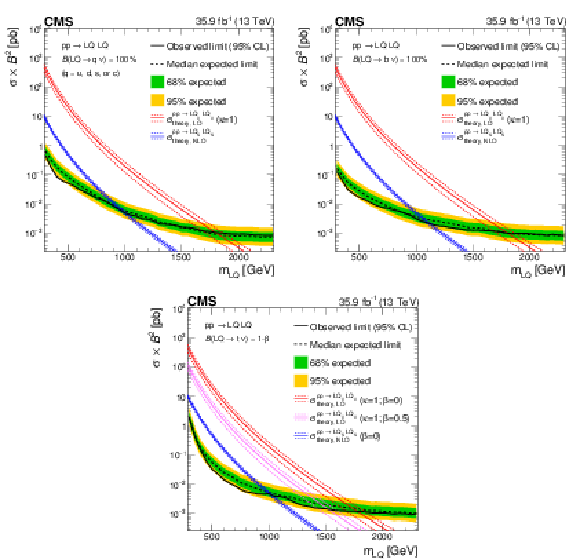
png pdf |
Figure 3:
The 95% CL upper limits on the production cross sections as a function of LQ mass for LQ pair production decaying with 100% branching fraction to a neutrino and (upper left) a light quark (one of u, d, s, or c), (upper right) a bottom quark, or (lower) a top quark. The solid (dashed) black line represents the observed (median expected) exclusion. The inner green (outer yellow) band indicates the region containing 68 (95%) of the distribution of limits expected under the background-only hypothesis. The blue (red) lines show the theoretical cross section for $ {\mathrm {LQ}_{\mathrm {S}}} ( {\mathrm {LQ}_{\mathrm {V}}} ) $ pair production with its uncertainty. (lower) Also shown in magenta is the product of the theoretical cross section and the square of the branching fraction ($B$), for vector LQ pair production assuming a 50% branching fraction to $ {{\mathrm {t}} {\nu}} _{\tau}$, with the remaining 50% to ${{\mathrm {b}} {\tau}}$. |

png pdf root |
Figure 3-a:
The 95% CL upper limits on the production cross sections as a function of LQ mass for LQ pair production decaying with 100% branching fraction to a neutrino and a light quark (one of u, d, s, or c). The solid (dashed) black line represents the observed (median expected) exclusion. The inner green (outer yellow) band indicates the region containing 68 (95%) of the distribution of limits expected under the background-only hypothesis. The blue (red) lines show the theoretical cross section for $ {\mathrm {LQ}_{\mathrm {S}}} ( {\mathrm {LQ}_{\mathrm {V}}} ) $ pair production with its uncertainty. |
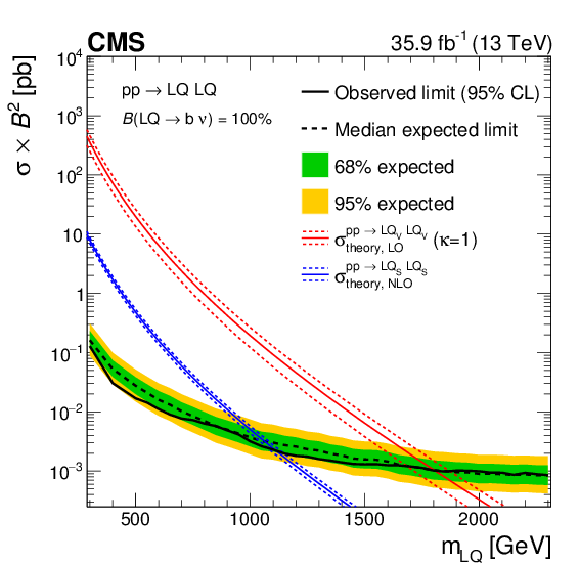
png pdf root |
Figure 3-b:
The 95% CL upper limits on the production cross sections as a function of LQ mass for LQ pair production decaying with 100% branching fraction to a neutrino and a bottom quark. The solid (dashed) black line represents the observed (median expected) exclusion. The inner green (outer yellow) band indicates the region containing 68 (95%) of the distribution of limits expected under the background-only hypothesis. The blue (red) lines show the theoretical cross section for $ {\mathrm {LQ}_{\mathrm {S}}} ( {\mathrm {LQ}_{\mathrm {V}}} ) $ pair production with its uncertainty. |
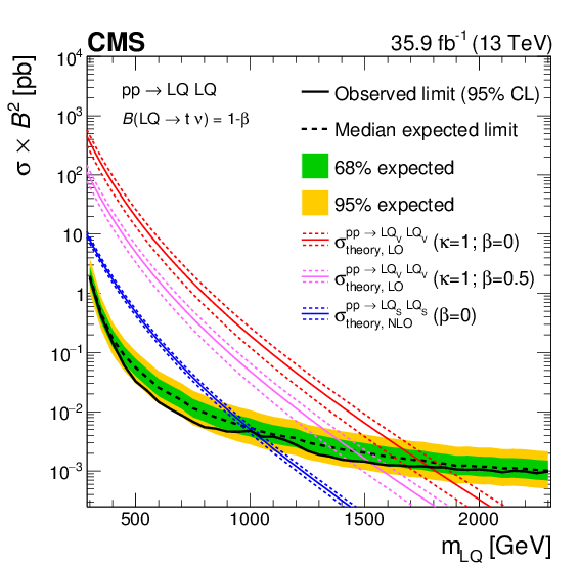
png pdf root |
Figure 3-c:
The 95% CL upper limits on the production cross sections as a function of LQ mass for LQ pair production decaying with 100% branching fraction to a neutrino and a top quark. The solid (dashed) black line represents the observed (median expected) exclusion. The inner green (outer yellow) band indicates the region containing 68 (95%) of the distribution of limits expected under the background-only hypothesis. The blue (red) lines show the theoretical cross section for $ {\mathrm {LQ}_{\mathrm {S}}} ( {\mathrm {LQ}_{\mathrm {V}}} ) $ pair production with its uncertainty. Also shown in magenta is the product of the theoretical cross section and the square of the branching fraction ($B$), for vector LQ pair production assuming a 50% branching fraction to $ {{\mathrm {t}} {\nu}} _{\tau}$, with the remaining 50% to ${{\mathrm {b}} {\tau}}$. |
| Summary |
| The CMS search for jets and missing transverse momentum using the $ {M_{\mathrm{T2}}} $ variable has been reinterpreted to place limits on leptoquark (LQ) pair production, where the LQ decays with 100% branching fraction to a quark and a neutrino. The search uses proton-proton collision data at $\sqrt{s} = $ 13 TeV, recorded with the CMS detector in 2016 and corresponding to an integrated luminosity of 35.9 fb$^{-1}$. Leptoquark decays to a neutrino and a top, bottom, or light quark are considered. Compared to the original result, higher masses are considered to place exclusion limits on both scalar and vector LQs. Assuming that there is only one LQ state within mass reach of the LHC, for a scalar (vector) LQ decaying to a light quark and a neutrino, masses below 980 (1790) GeV are excluded at the 95% confidence level by the observed data. For an LQ decaying to $ {\mathrm{b}\nu} $, masses below 1100 (1810) GeV are excluded, and for an LQ decaying to $ {\mathrm{t}\nu} $, masses below 1020 (1780) GeV are excluded. At high LQ mass values, these results improve the upper limits on LQ pair production cross sections over the extrapolation assumed in Ref. [39] by factors of as much as 1.2, 1.5, and 2.8 for the light quark and neutrino, $ {\mathrm{b}\nu} $, and $ {\mathrm{t}\nu} $ cases respectively. In the model of Refs. [37,38], a vector LQ with 50% branching fraction to $ {\mathrm{t}\nu} $, and 50% to $ {\mathrm{b}\tau} $, is predicted to explain anomalous flavor physics results. Masses below 1530 GeV are excluded for such a state assuming the Yang-Mills case with coupling $\kappa = $ 1, considering only the events with both LQ decaying to $ {\mathrm{t}\nu} $, providing the strongest constraint to date in this model from pair production. |
| References | ||||
| 1 | J. C. Pati and A. Salam | Unified lepton-hadron symmetry and a gauge theory of the basic interactions | PRD 8 (1973) 1240 | |
| 2 | J. C. Pati and A. Salam | Lepton number as the fourth color | PRD 10 (1974) 275, . [Erratum: \DOI10.1103/PhysRevD.11.703.2] | |
| 3 | H. Georgi and S. L. Glashow | Unity of all elementary particle forces | PRL 32 (1974) 438 | |
| 4 | H. Fritzsch and P. Minkowski | Unified interactions of leptons and hadrons | Ann. Phys. 93 (1975) 193 | |
| 5 | S. Dimopoulos and L. Susskind | Mass without scalars | NPB 155 (1979) 237 | |
| 6 | S. Dimopoulos | Technicolored signatures | NPB 168 (1980) 69 | |
| 7 | E. Farhi and L. Susskind | Technicolor | PR 74 (1981) 277 | |
| 8 | K. D. Lane and M. V. Ramana | Walking technicolor signatures at hadron colliders | PRD 44 (1991) 2678 | |
| 9 | B. Schrempp and F. Schrempp | Light leptoquarks | PLB 153 (1985) 101 | |
| 10 | B. Gripaios | Composite leptoquarks at the LHC | JHEP 02 (2010) 045 | 0910.1789 |
| 11 | G. R. Farrar and P. Fayet | Phenomenology of the production, decay, and detection of new hadronic states associated with supersymmetry | PLB 76 (1978) 575 | |
| 12 | P. Ramond | Dual theory for free fermions | PRD 3 (1971) 2415 | |
| 13 | Y. A. Golfand and E. P. Likhtman | Extension of the algebra of Poincar$ \'e $ group generators and violation of p invariance | JEPTL 13 (1971)323 | |
| 14 | A. Neveu and J. H. Schwarz | Factorizable dual model of pions | NPB 31 (1971) 86 | |
| 15 | D. V. Volkov and V. P. Akulov | Possible universal neutrino interaction | JEPTL 16 (1972)438 | |
| 16 | J. Wess and B. Zumino | A Lagrangian model invariant under supergauge transformations | PLB 49 (1974) 52 | |
| 17 | J. Wess and B. Zumino | Supergauge transformations in four dimensions | NPB 70 (1974) 39 | |
| 18 | P. Fayet | Supergauge invariant extension of the Higgs mechanism and a model for the electron and its neutrino | NPB 90 (1975) 104 | |
| 19 | H. P. Nilles | Supersymmetry, supergravity and particle physics | PR 110 (1984) 1 | |
| 20 | R. Barbier et al. | R-parity violating supersymmetry | PR 420 (2005) 1 | hep-ph/0406039 |
| 21 | BaBar Collaboration | Evidence for an excess of $ \bar{B} \to D^{(*)} \tau^-\bar{\nu}_\tau $ decays | PRL 109 (2012) 101802 | 1205.5442 |
| 22 | BaBar Collaboration | Measurement of an excess of $ \bar{B} \to D^{(*)}\tau^- \bar{\nu}_\tau $ decays and implications for charged Higgs bosons | PRD 88 (2013) 072012 | 1303.0571 |
| 23 | Belle Collaboration | Observation of $ B^0 \to D^{*-} \tau^+ \nu_\tau $ decay at Belle | PRL 99 (2007) 191807 | 0706.4429 |
| 24 | Belle Collaboration | Observation of $ B^+ \to \bar{D}^{*0} \tau^+ \nu_\tau $ and evidence for $ B^+ \to \bar{D}^0 \tau^+ \nu_\tau $ at Belle | PRD 82 (2010) 072005 | 1005.2302 |
| 25 | Belle Collaboration | Measurement of the branching ratio of $ \bar{B} \to D^{(\ast)} \tau^- \bar{\nu}_\tau $ relative to $ \bar{B} \to D^{(\ast)} \ell^- \bar{\nu}_\ell $ decays with hadronic tagging at Belle | PRD 92 (2015) 072014 | 1507.03233 |
| 26 | Belle Collaboration | Measurement of the $ \tau $ lepton polarization and $ R(D^*) $ in the decay $ \bar{B} \to D^* \tau^- \bar{\nu}_\tau $ | PRL 118 (2017) 211801 | 1612.00529 |
| 27 | LHCb Collaboration | Measurement of form-factor-independent observables in the decay $ B^{0} \to K^{*0} \mu^+ \mu^- $ | PRL 111 (2013) 191801 | 1308.1707 |
| 28 | LHCb Collaboration | Test of lepton universality using $ B^{+}\rightarrow K^{+}\ell^{+}\ell^{-} $ decays | PRL 113 (2014) 151601 | 1406.6482 |
| 29 | LHCb Collaboration | Measurement of the ratio of branching fractions $ \mathcal{B}(\bar{B}^0 \to D^{*+}\tau^{-}\bar{\nu}_{\tau})/\mathcal{B}(\bar{B}^0 \to D^{*+}\mu^{-}\bar{\nu}_{\mu}) $ | PRL 115 (2015) 111803 | 1506.08614 |
| 30 | LHCb Collaboration | Angular analysis of the $ B^{0} \to K^{*0} \mu^{+} \mu^{-} $ decay using 3 fb$ ^{-1} $ of integrated luminosity | JHEP 02 (2016) 104 | 1512.04442 |
| 31 | LHCb Collaboration | Test of lepton universality with $ B^{0} \rightarrow K^{*0}\ell^{+}\ell^{-} $ decays | JHEP 08 (2017) 055 | 1705.05802 |
| 32 | M. Tanaka and R. Watanabe | New physics in the weak interaction of $ \bar B\to D^{(*)}\tau\bar\nu $ | PRD 87 (2013) 034028 | 1212.1878 |
| 33 | Y. Sakaki, M. Tanaka, A. Tayduganov, and R. Watanabe | Testing leptoquark models in $ \bar B \to D^{(*)} \tau \bar\nu $ | PRD 88 (2013) 094012 | 1309.0301 |
| 34 | I. Dor\vsner, S. Fajfer, N. Ko\vsnik, and I. Ni\vsand\vzi\'c | Minimally flavored colored scalar in $ \bar B \to D^{(*)} \tau \bar \nu $ and the mass matrices constraints | JHEP 11 (2013) 084 | 1306.6493 |
| 35 | B. Gripaios, M. Nardecchia, and S. A. Renner | Composite leptoquarks and anomalies in $ B $-meson decays | JHEP 05 (2015) 006 | 1412.1791 |
| 36 | M. Bauer and M. Neubert | Minimal leptoquark explanation for the R$ _{D^{(*)}} $ , R$ _K $ , and $ (g-2)_\mu $ anomalies | PRL 116 (2016) 141802 | 1511.01900 |
| 37 | D. Buttazzo, A. Greljo, G. Isidori, and D. Marzocca | B-physics anomalies: a guide to combined explanations | JHEP 11 (2017) 044 | 1706.07808 |
| 38 | I. Dor\vsner and A. Greljo | Leptoquark toolbox for precision collider studies | 1801.07641 | |
| 39 | B. Diaz, M. Schmaltz, and Y.-M. Zhong | The leptoquark hunter's guide: Pair production | JHEP 10 (2017) 097 | 1706.05033 |
| 40 | ATLAS Collaboration | Searches for scalar leptoquarks in pp collisions at $ \sqrt{s} = $ 8 TeV with the ATLAS detector | EPJC 76 (2016) 5 | 1508.04735 |
| 41 | CMS Collaboration | Search for third-generation scalar leptoquarks decaying to a top quark and a $ \tau $ lepton at $ \sqrt{s} = $ 13 TeV | Submitted to \it EPJC | CMS-B2G-16-028 1803.02864 |
| 42 | CMS Collaboration | Search for pair production of first and second generation leptoquarks in proton-proton collisions at $ \sqrt{s} = $ 8 TeV | PRD 93 (2016) 032004 | CMS-EXO-12-041 1509.03744 |
| 43 | CMS Collaboration | Search for pair production of third-generation scalar leptoquarks and top squarks in proton-proton collisions at $ \sqrt{s} = $ 8 TeV | PLB 739 (2014) 229 | CMS-EXO-12-032 1408.0806 |
| 44 | H1 Collaboration | Search for first generation leptoquarks in $ ep $ collisions at HERA | PLB 704 (2011) 388 | 1107.3716 |
| 45 | ZEUS Collaboration | Search for first-generation leptoquarks at HERA | PRD 86 (2012) 012005 | 1205.5179 |
| 46 | ATLAS Collaboration | Search for third generation scalar leptoquarks in pp collisions at $ \sqrt{s} = $ 7 TeV with the ATLAS detector | JHEP 06 (2013) 033 | 1303.0526 |
| 47 | CMS Collaboration | Search for third-generation scalar leptoquarks and heavy right-handed neutrinos in final states with two tau leptons and two jets in proton-proton collisions at $ \sqrt{s}= $ 13 TeV | JHEP 07 (2017) 121 | CMS-EXO-16-023 1703.03995 |
| 48 | C. G. Lester and D. J. Summers | Measuring masses of semi-invisibly decaying particles pair produced at hadron colliders | PLB 463 (1999) 99 | hep-ph/9906349 |
| 49 | CMS Collaboration | Search for new phenomena with the $ M_{\mathrm {T2}} $ variable in the all-hadronic final state produced in proton-proton collisions at $ \sqrt{s} = $ 13 TeV | EPJC 77 (2017) 710 | CMS-SUS-16-036 1705.04650 |
| 50 | CMS Collaboration | The CMS experiment at the CERN LHC | JINST 3 (2008) S08004 | CMS-00-001 |
| 51 | CMS Collaboration | Particle-flow reconstruction and global event description with the CMS detector | JINST 12 (2017) P10003 | CMS-PRF-14-001 1706.04965 |
| 52 | M. Cacciari, G. P. Salam, and G. Soyez | The anti-$ {k_{\mathrm{T}}} $ jet clustering algorithm | JHEP 04 (2008) 063 | 0802.1189 |
| 53 | M. Cacciari, G. P. Salam, and G. Soyez | FastJet user manual | EPJC 72 (2012) 1896 | 1111.6097 |
| 54 | CMS Collaboration | Identification of heavy-flavour jets with the CMS detector in pp collisions at 13 TeV | JINST 13 (2018) P05011 | CMS-BTV-16-002 1712.07158 |
| 55 | J. Alwall et al. | The automated computation of tree-level and next-to-leading order differential cross sections, and their matching to parton shower simulations | JHEP 07 (2014) 079 | 1405.0301 |
| 56 | NNPDF Collaboration | Parton distributions for the LHC run II | JHEP 04 (2015) 040 | 1410.8849 |
| 57 | T. Sjostrand et al. | An introduction to PYTHIA 8.2 | CPC 191 (2015) 159 | 1410.3012 |
| 58 | CMS Collaboration | Event generator tunes obtained from underlying event and multiparton scattering measurements | EPJC 76 (2016) 155 | CMS-GEN-14-001 1512.00815 |
| 59 | J. Alwall et al. | Comparative study of various algorithms for the merging of parton showers and matrix elements in hadronic collisions | EPJC 53 (2008) 473 | 0706.2569 |
| 60 | GEANT4 Collaboration | GEANT4 -- a simulation toolkit | NIMA 506 (2003) 250 | |
| 61 | CMS Collaboration | The fast simulation of the CMS detector at LHC | J. Phys. Conf. Ser. 331 (2011) 032049 | |
| 62 | N. Arkani-Hamed et al. | MARMOSET: The path from LHC data to the new standard model via on-shell effective theories | hep-ph/0703088 | |
| 63 | J. Alwall, P. C. Schuster, and N. Toro | Simplified models for a first characterization of new physics at the LHC | PRD 79 (2009) 075020 | 0810.3921 |
| 64 | J. Alwall, M.-P. Le, M. Lisanti, and J. G. Wacker | Model-independent jets plus missing energy searches | PRD 79 (2009) 015005 | 0809.3264 |
| 65 | D. Alves et al. | Simplified models for LHC new physics searches | JPG 39 (2012) 105005 | 1105.2838 |
| 66 | CMS Collaboration | Interpretation of searches for supersymmetry with simplified models | PRD 88 (2013) 052017 | CMS-SUS-11-016 1301.2175 |
| 67 | NNPDF Collaboration | Parton distributions with LHC data | NPB 867 (2013) 244 | 1207.1303 |
| 68 | NNPDF Collaboration | Parton distributions from high-precision collider data | EPJC 77 (2017) 663 | 1706.00428 |
| 69 | T. Junk | Confidence level computation for combining searches with small statistics | NIMA 434 (1999) 435 | hep-ex/9902006 |
| 70 | A. L. Read | Presentation of search results: the CL$ _{\text{s}} $ technique | in Durham IPPP Workshop: Advanced Statistical Techniques in Particle Physics, p. 2693 Durham, UK, March, 2002 [JPG 28 (2002) 2693] | |
| 71 | G. Cowan, K. Cranmer, E. Gross, and O. Vitells | Asymptotic formulae for likelihood-based tests of new physics | EPJC 71 (2011) 1554 | 1007.1727 |
| 72 | ATLAS and CMS Collaborations | Procedure for the LHC Higgs boson search combination in summer 2011 | CMS-NOTE-2011-005 | |
| 73 | CMS Collaboration | CMS luminosity measurements for the 2016 data taking period | CMS-PAS-LUM-17-001 | CMS-PAS-LUM-17-001 |

|
Compact Muon Solenoid LHC, CERN |

|

|

|

|

|

|